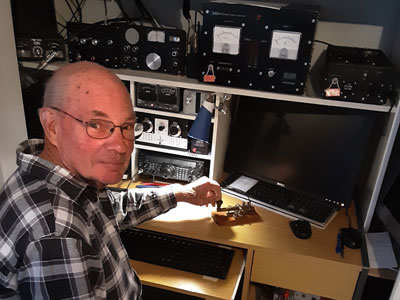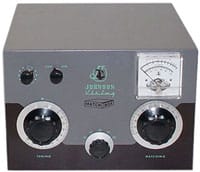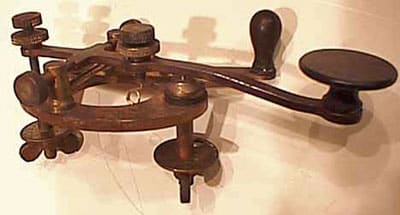This is a fortnightly newsletter about the New Zealand Net.
If you would like to be notified by email message when a new edition is published, please contact ZL1NZ.
You are also welcome to browse our newsletter archive.
Featured operator: ZL2LN
Over the past few days, Barry ZL2LN has been checking into the net from his portable station while travelling. But when he’s at home in Motueka, this is his setup. Barry got his ticket in 1959, so it’s not surprising that he knows how to homebrew a very nice station. I asked him to describe it:
 “My shack is set up in half of a wardrobe in the spare bedroom. If I pull the sliding door across, nobody would know it was there.
“My shack is set up in half of a wardrobe in the spare bedroom. If I pull the sliding door across, nobody would know it was there.
“Apart from the FT-847 transceiver, all my gear is home brew. I like black.
“My other very active interest is digital EME on 2 metres. I have a 4-bay 8-element array.
“Bottom left is 500 watt HF amp using an 813. Above, on the shelf, is an 80 metre CW QRP rig using a 6V6, output about 6 watts. Next to it is an 80 metre receiver. I have used this combo a couple of times on the net.
“To the right is a 2 metre 1kW amp for EME.
“Any repairs or construction project has to be carried out in our garage, being in a small 2-bedroom house with single garage means making the most of what space is available.”
– Barry
How about some pictures and info on other Net members? Please send them to me for inclusion in future newsletters.
Quick notes
Bruce ZL1BWG has been helping out with some North Island QNG1 when Dave and Grant are net control stations. It’s always good to have stations on both islands calling for check-ins. So stay alert, NCS may call on you!
Signals from Australia seem better in the past few days. Manny VK3DRQ was QRK3 here one evening, which would have been OK for traffic, and other stations with less local noise were hearing him much better than I was.
 All this rainy weather is playing havoc with the doublet aerial at ZL1NZ. The other night I tuned up just before the net, then noticed the SWR was way too high just a couple of minutes into the net. Had to stop the net, while I went to the other end of the shack to adjust the transmatch again. I’m actually fortunate to have an automatic high-SWR alarm in my shack – the lights start to flicker when I’m keying!
All this rainy weather is playing havoc with the doublet aerial at ZL1NZ. The other night I tuned up just before the net, then noticed the SWR was way too high just a couple of minutes into the net. Had to stop the net, while I went to the other end of the shack to adjust the transmatch again. I’m actually fortunate to have an automatic high-SWR alarm in my shack – the lights start to flicker when I’m keying!
We haven’t had many ops joining the Zoom video conference recently. I suppose the novelty wore off, which is understandable, since most of us have been doing heaps of video conferencing due to Covid. From now on I’ll only be running Zoom on Wednesdays, when I am net control. But if anyone wants me to fire it up on another day, just let me know.
After this week’s NZ Net Trivia question, which asked the meaning of the Morse prosign <SN>, it was amusing to hear it being used a bit on the Net. If this prosign is unfamiliar to you, here’s a list of prosigns. <SN>?
The leg key
One of our recent NZ Net Trivia questions asked how “leg keys” got their name:

From tom-perera.com
Early keys, such as the one pictured here, were often made with two legs for bolting to the table top.
Not only did this prevent the key from moving, it also made the wiring invisible, because the leads were attached to the legs, under the table top. Clever!
Memorial Contest next weekend
The NZART’s annual Memorial Contest is next weekend (4th and 5th July) from 8 to 11pm (0800-1100Z).
Deadline for SKN logs
Speaking of contests, the deadline for submitting your Straight Key Night log is next Tuesday, 30 June.
Top scores will be announced first in a QNC (message to all stations) during the NZ Net on Wednesday 1 July.
The telegraphist’s ‘mill’
Landline and maritime telegraphists (or telegraphers, as they were called in North America) often copied messages using a special form of typewriter affectionately referred to as a mill.
The mill had a couple of distinctive features: there was no lower case, and the zero had a slash to distinguish it from the letter O.
The mill style can be seen in the message below, which I typed up after receiving it in Morse at ZL1ZLD Musick Point a couple of years ago. I typed on a computer, using a font that imitates the look of a traditional mill.

The font, called Telegrapher’s Mill, was created several years ago by a US telegrapher, who photographed each letter produced on a mill, then cleaned up the images but kept that slightly blurry look you’d get from a typewriter ribbon.
I use this font all the time when typing up radiograms for transmission. If you’re interested in having it on your computer (it’s a truetype font, which installs on Windows computers – no idea about Macs) just drop me a line and I’ll email it to you.
Shortest telegram ever?
A missionary priest was giving a mission at a parish and a visiting priest asked the missionary to come to his parish next.
Permission from the missionary’s superior was needed, so the missionary “wired” for it. A prompt and waggish answer came with the letter I for the text – two dits, no more.
I, in Latin, is the single imperative form of the verb ire, meaning to go. So the answer “I” meant “Go”.
Was there ever a telegram shorter than two dits?
– From Morsum Magnificat, Number 1, Autumn 1986 (No further details available)
Net tip: CFM
In previous newsletters, we’ve talked about what to do if you’re copying formal traffic and you need a repeat of part of the message because you did not copy it 100%. You probably remember that “fills” are requested using BN, WA, WB, AA or AB.
 But what do you do if you copy the message perfectly, but it appears to contain an error? Say, for example, you copied this:
But what do you do if you copy the message perfectly, but it appears to contain an error? Say, for example, you copied this:
WILL BE ARRIVING 31 JUNE
You’re positive that’s what the other op sent, but obviously there are only 30 days in June!
This is where you would use CFM (Confirm), by sending:
CFM 31
The sending op may then respond with something like:
CORRECTION PSE CHANGE TO 21
Carrying this one step further, suppose the sending op didn’t originate the message but is relaying it from someone else, and didn’t notice the error when they copied it. Before the message goes any further, the sending op needs to contact the operator from whom they got the message, in order to sort out the error. That’s handled by a SVC (Service) message – which sounds like a good topic for the next newsletter. 🙂
Suggestions?
If you have suggestions on how to make the NZ Net better, or things you’d like to see covered in these updates, please contact ZL1NZ. You might even like to write something for the newsletter.
Thanks for reading, and I hope to see you soon on the NZ Net!
—
Neil Sanderson ZL1NZ, Net Manager
New Zealand Net (NZ NET)
3535.0 kHz at 9pm NZT Mon-Fri



